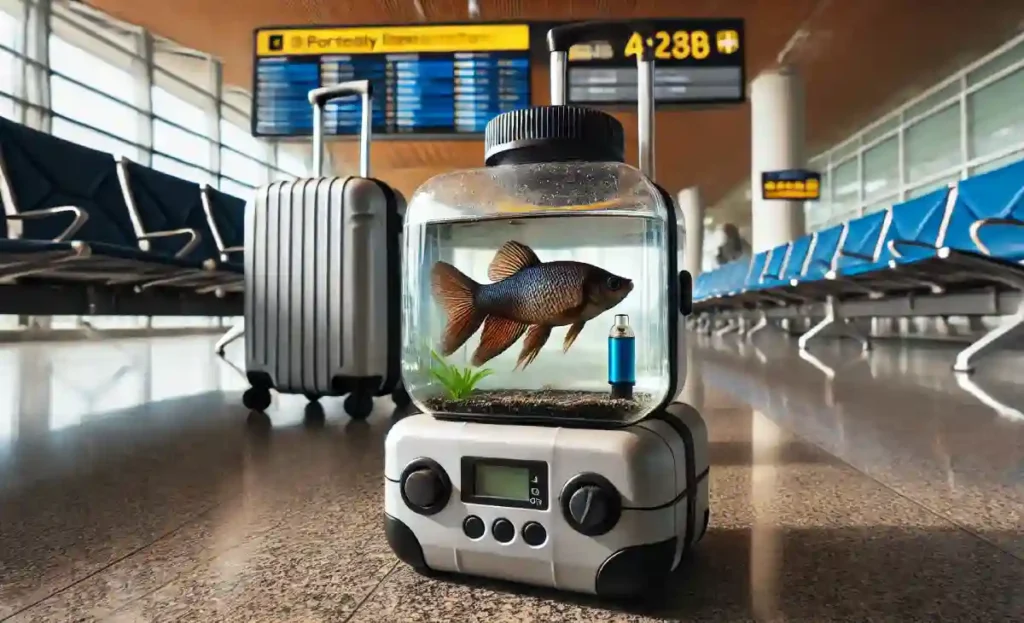Traveling with fish requires careful planning. Keep them in a safe, clean container during the trip. Fish need stable conditions during travel, as they are sensitive to changes in their environment. Proper planning includes selecting the right container, ensuring water quality, and minimizing stress. Did you know fish can live up to 7 hours in a well-packed container? The water needs to be conditioned, and oxygen levels kept steady. Whether it’s a short or long trip, you can move your fish safely. Follow these simple steps to keep them protected.
Let’s dive into how you can prepare, pack, and transport your fish with confidence.
Preparing Your Fish for Travel

Proper preparation is essential for a successful journey with your fish. This means choosing the right travel container and conditioning the water. Reducing your fish’s stress is key. By planning ahead, you can keep your fish safe and comfortable during the trip.
Choose the Right Container:
Choosing the right container is one of the most important steps when traveling with fish. Regular aquariums are too fragile for travel and hard to carry. Instead, use small containers like plastic bags or special fish travel containers, depending on your trip length.
- Short Trips (Under 2 Hours): For short trips, plastic bags work well. To transport fish, use a bag designed for that purpose. Fill it one-third with tank water and two-thirds with air to ensure sufficient oxygen for the fish. If you want to avoid leaks, you should double-bag. During travel, secure the bag to prevent it from tipping over.
- Long Trips (More Than 2 Hours):For longer trips, use a sturdy container like a portable fish tank, cooler, or bucket with a lid. These containers offer better protection and keep the water from sloshing too much. Make sure to use a container that allows for easy aeration or has room for a portable air pump.
Prepare Your Fish Before the Trip:
Before traveling, prepare your fish by not feeding them for at least 24 hours. Fish produce waste after eating, which can pollute the water during travel. An empty stomach helps keep the water cleaner and your fish healthier. Fish can go several days without food, so this won’t harm them.
Additionally, try to keep the fish’s environment calm before the trip. Reduce light exposure or cover the tank to create a more peaceful setting. This helps reduce stress, making the transition to the travel container easier.
Maintaining Water Quality During the Trip
Water quality is a crucial factor for your fish’s well-being during travel. Changes in water chemistry can stress or harm your fish. It’s important to keep the water clean and stable during the trip. Fish rely on the water to stay healthy, so providing the best possible environment is key.
Test and Treat the Water Before Traveling:
To ensure optimal water quality, start by using water from the fish’s tank for the travel container. When placed in unfamiliar water, this reduces the shock. Use a water testing kit to check pH and ammonia levels before the trip. A pH between 6.5 and 7.5 is generally ideal for most fish species. If necessary, add a water conditioner to neutralize harmful substances like chlorine or heavy metals in the water.
For trips longer than a few hours, consider using an air stone or a battery-operated air pump to keep the water oxygenated. Without proper aeration, fish can become stressed due to a lack of oxygen, especially in warmer temperatures.
Keeping Water Temperature Stable
Fish are sensitive to temperature changes, which can cause them significant stress during pet travel. Maintaining a stable water temperature is critical to ensuring their health and safety. Even slight changes in temperature can affect the fish’s metabolism and immune system.
Insulated Containers and Temperature Control:
To prevent temperature fluctuations, use an insulated container like a cooler or fish travel bag. These containers help maintain the water temperature, keeping it stable throughout the journey. If you’re traveling in very hot or cold weather, extra equipment may be needed. This helps keep the water temperature right for your fish.
- In Cold Weather: Use a portable battery-operated heater or place heat packs near the container to maintain warmth.
- In Hot Weather: Keep the container in a shaded area of your vehicle and use cooling packs or a small fan to keep the water temperature within a safe range.
Regularly check the temperature during the trip, and if necessary, adjust it using a portable heater or cooler.
Reducing Stress During the Journey
Fish are prone to stress, especially when their environment changes suddenly. Stress can make fish more vulnerable to illness, so it’s crucial to minimize any factors that might cause it during travel. Simple steps can help keep your fish calm and comfortable throughout the journey.
Keep the Environment Calm and Dark:
One effective way to reduce stress is to limit light exposure and noise. Fish feel calmer in darker environments with minimal movement. Keep the container in a quiet, stable part of your vehicle. You can cover the container with a cloth to block out light, which helps keep the fish calm. Avoid placing the container in direct sunlight or near loud noises, as this can disturb your fish and cause stress.
Traveling for Short Trips
Short trips, such as visiting the vet or moving within the same city, are less demanding for your fish. But, even for short trips, taking precautions can prevent unnecessary stress or injury.
Use Plastic Bags for Short Journeys:
For trips that last under two hours, transporting fish in plastic bags filled with water is a simple and effective solution. Fill the bag with water from the tank and leave enough space for air. Oxygen tablets can also help increase oxygen levels during the trip. Secure the bag upright in a dark, cool space to keep your fish calm. Avoid placing the bag in direct sunlight or an overheated environment.
Traveling for Long Trips
Longer trips need extra preparation and the right gear to keep your fish healthy. It is harder to maintain water quality and temperature, so planning ahead is key.
Use a Portable Tank or Cooler:
For trips longer than two hours, use a portable tank or cooler with a lid. These containers are more durable and can maintain water conditions better than plastic bags. Add a portable air pump or air stone to provide proper aeration and oxygenate the water. Bring extra water in case you need to change it during the trip. If the water starts to get dirty, replace it with clean water from your tank to maintain water quality.
Traveling by Air with Fish

If you need to travel by air with your fish, you must follow specific airline regulations. Not all airlines allow fish in carry-on luggage, so check their rules before you book your flight. Air travel adds another level of complexity, so make sure you prepare properly.
Check Airline Regulations:
Before you travel, check your airline’s rules for carrying live fish. Most airlines allow fish in small, leak-proof containers, but they have size and weight limits. Most airlines need fish to be in a clear plastic bag or container. This bag is then placed in a secure box or cooler to prevent leaks.
Ensure the container is secure and won’t tip over during the flight. If you’re traveling internationally, you might need proof that your fish are healthy. They must also meet import rules for the country you’re visiting.
Acclimating Fish After the Trip
Once you arrive at your destination, it’s important to help your fish acclimate to their new environment. Moving from one water condition to another can cause shock, so the transition must be gradual.
Float the Container in the New Tank:
Start by floating the travel container in the new tank for 15-20 minutes. This allows the water temperature to equalize between the container and the tank. Slowly introduce water from the new tank into the container to help the fish adjust to the new water chemistry. After about 30 minutes, carefully release the fish into their new tank.
For more details on traveling with fish and caring for them during transport, check out this guide on fish transportation.
FAQs
How long can fish stay in a travel container?
Fish can safely stay in a travel container for 5-7 hours, provided the water is conditioned and oxygenated properly. For longer trips, check the water quality and change the water if necessary.
Is it safe to fly with fish?
Yes, it is safe to fly with fish if you follow airline guidelines. Use a leak-proof container and ensure it fits within the airline’s carry-on size requirements.
Can fish survive without a filter during travel?
Yes, fish can survive without a filter for short trips. For longer trips, use a portable air pump or air stone to ensure proper oxygenation of the water.
Should I feed my fish before traveling?
No, you should avoid feeding your fish for at least 24 hours before traveling. This keeps the water cleaner during transport by reducing waste production.
Conclusion
Traveling with fish may seem daunting, but with proper planning and the right equipment, it becomes much easier. By properly preparing your fish, you can keep them safe during travel. Maintaining water quality and reducing stress are key to their well-being.
Whether you are moving locally or taking a long trip, these tips will help. They can make the journey stress-free for both you and your fish.




